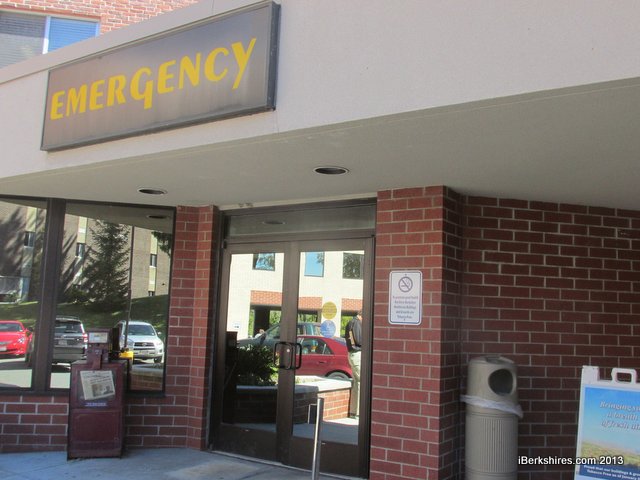NARH Reduces Emergency Room Wait Times
|

North Adams Regional Hospital has put a focus on reducing wait times in the emergency room.
|
NORTH ADAMS, Mass. — A month-old initiative to lower Emergency Room waiting times is already paying dividends at North Adams Regional Hospital.
Between Aug. 20 and Sept. 18, the average time it takes to enter a room in the ER dropped from 15 minutes to six minutes, and the average time to see a doctor after entering the building dropped from 27 minutes to 19 minutes.
On Tuesday morning, the "Lean management" team created to assess and improve the ER reassembled to talk about the process, the changes and the tangible results so far.
The group was encouraged by a dramatic improvement in the hospital's ER's rankings according to the most recent Press Ganey patient satisfaction survey.
For the period from April to July of this year, the hospital's ER ranked in the 63rd percentile in the Northeast for overall satisfaction. for August, it ranked in the 97th percentile. Nationally, NARH ranked in the 72nd percentile for the previous four months; in August, it ranked in the 94th percentile.
"This is the best the Emergency Department has ever performed," said Paula Markland, the hospital's patient relations manager. "We've been with Press Ganey since their beginning. We were the 30th hospital that joined their system, and now they have thousands."
Indiana-based Press Ganey is partnered with 10,000 healthcare organizations nationwide, according to its website.
Markland was one member of a "cross-functional" team that spent four days this summer doing nothing but developing a new plan for the hospital's emergency room.
The group followed the "Kaizen" model, named for the Japanese words Kai, which means "change" and Zen, which means "good." Kaizen systems look to constantly improve systems in businesses; the approach dovetails with the Lean management approach expounded by Northern Berkshire Healthcare CEO Tim Jones.
"[Lean management] is understanding what customers value and looking at the processes that deliver services," NARH Director of Lean Transformation Brent Drennan said. "Tim Jones got us thinking about what the patients want. In the Kaizen process, we asked, 'What is it that's bothering patients?' It's that they're waiting too long to see a provider."
Drennan served on the Kaizen team along with Markland, interim Emergency Department Director John Aufdengarten, ER nurse Cherie Ericson, housekeeper Theresa Rondeau, physician recruiter Bonnie Clark, ER physician Dr. Fernando Ponce, admissions officer Renee Eastman and information technology specialist Samantha Ritcher.
"The key is to bring everyone into the discussion," said Dr. Jonathan Cluett, an orthopedic surgeon who stood in for Ponce at Tuesday's meeting.
The participants described the four-day process as intense, tiring, challenging and productive.
The most noticeable change that emerged -- from a patient standpoint -- is the transformation of the triage room.
Before Aug. 20, that room was a way station where incoming patients would spend anywhere from two to 15 minutes answering 30 questions as the triage nurse went through 50 different computer screens -- all before the patients were allowed to enter a room where they would receive care.
Now, the model calls for a 15-second triage that speeds patients directly from the waiting room to the treatment room and prevents backups that used to subject some patients to very long waits in the reception area before they even saw a nurse.
From a staffing perspective, the new model allows more nurses to focus on patient care, Ericson explained. No added staffing costs were associated with the changes.
"At peak times, from 11 a.m. to 9 p.m., we have five RNs on duty," she said. "[Before] we had a triage nurse who took no patients and a charge nurse who took a reduced load, maybe half a patient load. So before we had 3-1/2 nurses at peak time seeing patients."
Now, four of those nurses are seeing patients and one assigned as the charge nurse to manage patient flow and do the 15-second assessments.
"If you ask a nurse how long it takes to tell how sick a person is," Drennan said. "It should take about 15 seconds."
That is not to say the things that used to happen in triage -- like taking a full medical history -- are ignored.
"The rest of it still gets done," Drennan said. "But it gets done later in the process."
In the meantime, patients feel more like their concerns are being taken seriously and progress is being made toward addressing their complaint.
"A patient's perception of staff changes dramatically," Markland said. "When a nurse cares enough to take you to a room right away, you perceive that that nurse is kinder and more interested."
And, in the end, more patients seek help.
Prior to implementation of the changes instituted by the Kaizen team, on average one person every other day left the NARH ER without seeing a physician. That was a measure of the frustration created by waiting room times.
On Tuesday, the hospital marked a run of 18 days since the last patient walked out without seeing a physician. It's a small sample size, but an impressive trend in the right direction.
The Kaizen group continues to meet weekly to discuss what works and what needs to be tweaked to improve ER performance, and the Kaizen model is going to be replicated in other parts of the hospital, Drennan said.
The next area to be addressed: how to do a better job serving the 10 to 12 percent of ER patients who are admitted to the hospital.
"We asked the Emergency Department nurses what we could do to help them, and their top response was, 'Please get people upstairs faster,' " Brennan said. "The next step is to work on admissions from the ER."